Understanding 92/117 & Decoding Badlaav – Kisan Andolan, Depoliticised Politics & a Punjab in search of an Inquilab
“THINGS fall apart; the centre cannot hold,” Yeats could have said this about Punjab’s politics. As the fulcrums of power, Shiromani Akali Dal (SAD) and Congress, both more than century-old parties, fell by the wayside, the country actually wants to understand what did the Aam Aadmi Party (AAP) do to score such a landslide win? Well, it was there, and that was all it had to do. The rest of the work was done by its competitors, who were not found wanting in working hard and wholeheartedly for their own defeat and for AAP’s victory that left SAD and Congress decimated to an extent where an eventual two-party system in the country could mean BJP versus AAP.
![“THINGS fall apart; the centre cannot hold,” Yeats could have said this about Punjab’s politics. As the fulcrums of power, Shiromani Akali Dal (SAD) and Congress, both more than century-old parties, fell by the wayside, the country actually wants to understand what did the Aam Aadmi Party (AAP) do to score such a landslide win? Well, it was there, and that was all it had to do. The rest of the work was done by its competitors, who were not […]](https://www.theworldsikhnews.com/wp-content/uploads/2022/03/Bhagwant-Mann-with-Kejriwal-360x266.jpg)
QUICK FIX ANALYSTS, WITH A PRONOUNCED PROCLIVITY TO SOUND NICE AND POLITE TO AN INCOMING REGIME, have tried to give credit for the 92/117 win to AAP’s ostensibly clever strategy, but the fact is that AAP received a robber’s haul of 42 per cent grudge vote, while it had contributed little in the manufacturing of that grudge.
For the entire duration of the Kisan Andolan that had kept politics paralysed for more than a year in Punjab, politicians of various political parties did the bidding of farm union leaders, afraid that any decision by them to jump headlong into the electoral arena would squeeze out the traditional parties from the field altogether.
And then, Modi’s capitulation on the farm bills was followed by a complete mess by the farm union leaders -what was clearly Modi’s defeat played out as confusion within protestors’ ranks. Stunned by BJP’s sudden surrender, they hardly knew how to play it out in Punjab, UP or elsewhere. Within days, the massive gains of the Andolan were frittered away, its leaders’ unity fell victim to their little egos and unduly hardcore stances, and soon any remnants of the Andolan who were adamant on fighting elections were pushed to the margins by fellow farm unionists.
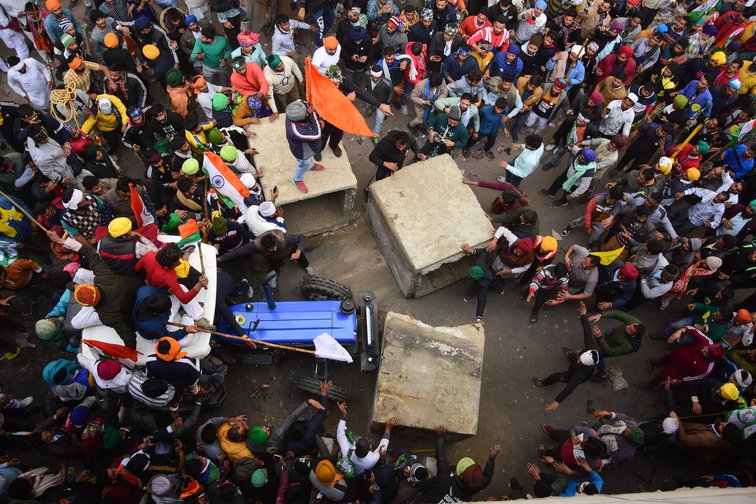
The Andolan by itself was a problematic movement. It spoke of the farmers’ fear of losing land – so, by definition, it was to guard the interests of the land-owning class. It claimed support of landless labourers – but they were there for sheer survival, not in search of social justice. It tried to expand its agenda to include human rights, but soon became wary of references to Kashmir or Art 370, and the human rights debate ran into a radical Sikhs versus comrades wall. It cried hoarse about Sudha Bharadwaj, but would meekly add the issue of using UAPA against Sikh youth. And the moment a debate about the land ceiling and land reforms hit the Andolan, the fissures widened to threaten unity.
But despite several problematic aspects, the Andolan was a success. Not just because it achieved its primary objective of forcing Modi’s hand on three farm laws, but because it had succeeded in stoking massive anger as well as consciousness about politics.
Punjab learnt to ask tough questions of politicians. In public, it played out as a random heckler at a street-corner election meeting hurling insult-wrapped-as-question to a farm economist raising complex issues in simple language at a seminar or an op-ed piece. Clearly, Punjab was seen as a people and a land in search of an alternative, and with a vengeance.
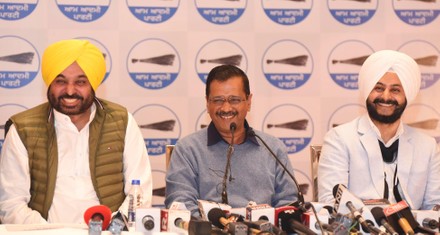
Punjab and Punjabis had been doing this exercise for long now. At one point, the enthusiasm for the short-lived People’s Party of Punjab (PPP) also reflected the same wish when Manpreet Singh Badal posed as a Don Quixote and Bhagwant Mann had tagged along as his Sancho Panza, both landing at Shaheed Bhagat Singh’s Khatkar Kalan village, holding fistfuls of soil in hand and vowing to change politics.
Manpreet Badal soon went back to old ways of doing politics, opposing subsidies or announcing new ones, depending upon political convenience, and finding a messiah in Amarinder Singh or a Charanjit Singh Channi, depending upon, well, the same thing. He has never depended upon anything else, not even Ghalib.
But Punjab wanted real change. The PPP experiment failed. Punjab hit back by electing four AAP MPs. The country took notice, but then the AAP experiment went awry. In 2017, Punjab came close to threatening to overturn the entire cart. Arvind Kejriwal was hoping for 100 seats but got only 20. Then half of them ran away. Nothing else had changed. The SAD and the Congress had failed for an entire decade to read the writing on the wall — that Punjab was asking for change. It desperately wanted change. It was trying time and again to do it wholesale.
This time, Punjabis translated it as “badlaav”. And no one who looked and acted the same as they had done for decades, could be that change.
The SAD and the Congress had failed for an entire decade to read the writing on the wall — that Punjab was asking for change. It desperately wanted change. It was trying time and again to do it wholesale.
Between the Congress government, first led by Amarinder Singh and later, for a little over 100 days, by Charanjit Singh Channi, and the principal opposition party SAD, led by Badal father and son duo, they had earned enough public opprobrium over the years as being the same side of the same coin but never felt the need to address the issue.
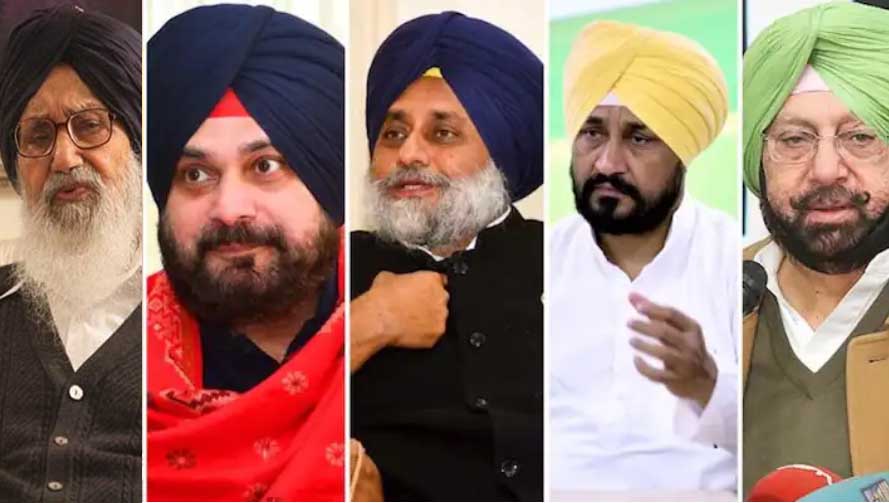
Amidst all this, Arvind Kejriwal and his Sancho Panza Bhagwant Singh Mann emerged as the biggest beneficiaries of the wave of anger consuming the people. While the rest of India saw the robust year-long Andolan merely as a resistance movement against three farm laws, in Punjab it had played out as a rejection of the way politics had been done by traditional parties for decades.
The more legitimate fighters for the change – the Kisan Andolan – had also picked up the same refrain. It castigated “rawaiti partiyan” day in and out from a stage that had captured the national imagination. “Don’t come anywhere near the stage,” it told politicians, thus bundling all hues into one.
Arvind Kejriwal and his Sancho Panza Bhagwant Singh Mann emerged as the biggest beneficiaries of the wave of anger consuming Punjabis who seemed adamant at rejecting gtthe way traditional parties had been doing politics for decades.
In Punjab, both, Congress and Akali Dal, were seen as parties that thrived in their close connections to big business. Nearly all major business sectors, including real estate, liquor, sugar, sand, transport, cable, education and health, came to be suffixed with a word from the Queen’s language that even the most illiterate of the Punjabis could understand and pronounce perfectly to the satisfaction of Professor Henry Higgins — “Mafia”. And politicians of one hue or the other were part of all these businesses.
AAP was successful in spinning it into a “people versus mafia” narrative.
The SAD had borne the brunt of people’s anger on the issue of sacrilege of holy Sikh scriptures in 2017, but neither the Badals nor the beneficiary of that anger, Congress, could address the highly surcharged issue in the last five years. The fact is that even the highly emotive issue of sacrilege was merely a weak link in the grudge chain against Akalis. People had seen the regime’s close links with several streams of business, the Badal family’s hold on the party, the general disconnect of the power elite from the masses, and perceived the regime to be harbouring corruption in its rank and leadership.
The Congress seemed no different. Its leaders were equally committed to mining sand from Punjab’s rivers, owning shopping complexes, running private schools, colleges, universities and hospitals, and buying land along newly planned highways and roads on the basis of advance information about urban development. The entire Akali and Congress political class had plunged headlong into the cesspool and the power elite openly talked about who had minted how many hundreds of crores in how short a time span.
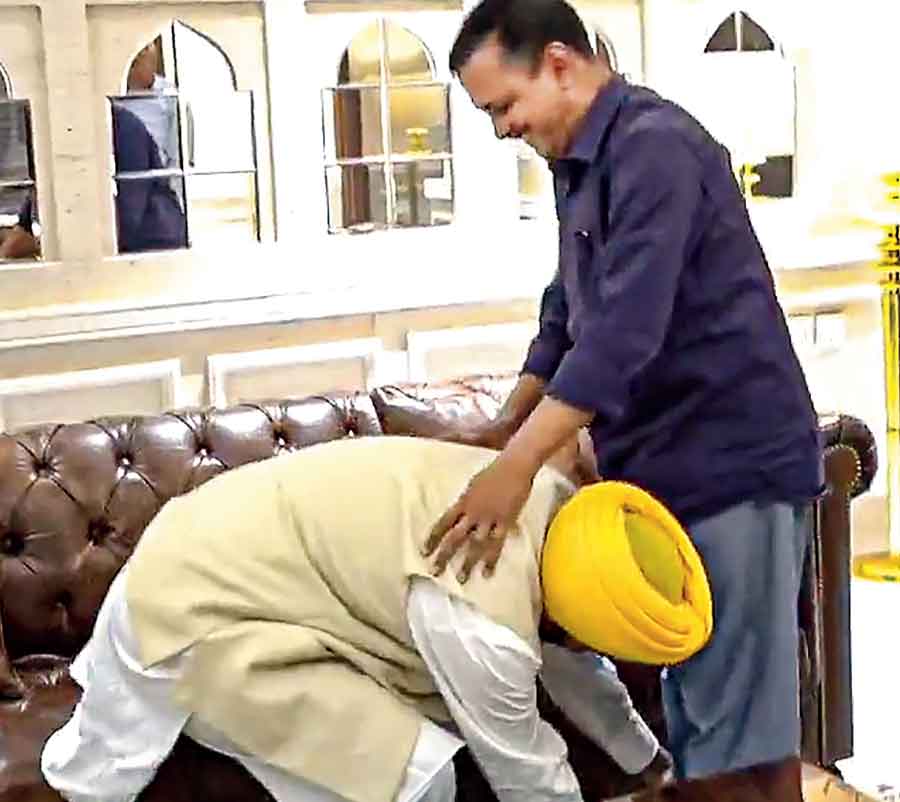
They forgot that people had been watching and listening, and were seething with anger. At best, they thought they will throw some crumbs to those too desperate.
And they had been bitten by the national bug called Modi rhetoric. Just as Amarinder Singh said he had made all the development plans for the state and was the saviour of not just Punjab but even of national security, Charanjit Singh Channi said he had done so much 111 days because Amarinder had done nothing in four and a half years. Sukhbir Badal had already been telling people for years that “jo keeta vadde Badal Sahib ne keeta.”
Additionally, the Akali Dal had a contract with the Panth – backed and legitimised by history and legacy, but often breached in contemporary political equation-building. The SAD had always claimed to be the Sikh/panthic community’s “Sole Spokesman,” to borrow a term from the subcontinental history of the heady but riotous mid-1940s and scholar historian Ayesha Jalal at the same time.
While the SAD desired to derive the core vote bank ballots from this “panthic contract”, it paid little attention to the fact that the Panth had long back terminated that contract ex-parte
While the SAD desired to derive the core vote bank ballots from this “panthic contract”, it paid little attention to the fact that the Panth had long back terminated that contract ex-parte. Once you design your politics around superhighways, new airports, swanky malls and Progressive Punjab summits, your concerns no more matching the innate interests of the community, neither the Sikh political nor its electoral stream was to remain bounden to Akali Dal’s history of being a watchdog of community interests.
As for the extraneous Sikh radical elements and those with a penchant to proclaim themselves as “true Panthic forces”, their own contribution remained next to zilch. The poll numbers in Amargarh owe more to the doggedness of the maverick Sikh nationalist leader, buttressed by an accident on a superhighway on the ramparts of Sultanate of Delhi.
The “true Panthic forces” constituency, including Dal Khalsa, the many other Panthic Dals or their iterations, hardly made any meaningful contribution to the debate in which Punjab and Panth found themselves embroiled for a long time. Their role, if any, remains a best-guarded super-secret. Have they understood the 92/117 result? Your guess is as good as mine.
Interestingly, even though incidentally, the Akali Dal had consciously given up identity politics exactly at a time when the BJP was successfully fashioning an entire paradigm of Hindutva politics around identity issues.
As for the extraneous Sikh radical elements and those with a penchant to proclaim themselves as “true Panthic forces”, their own contribution remained next to zilch.
It’s not that the Sikh community had not been facing issues. In the past few years, a number of issues emerged in Punjab that found resonance with the community, be it the fate of Beant Singh-killer Balwant Singh Rajoana, the political Sikh prisoners in various jails languishing since the mid-1980s, Devinder Pal Singh Bhullar or the needling by RSS. In fact, Sikhism’s long and deep-rooted resistance to Hindutva politics and the idea of turning India into a Hindu Rashtra was underlined by Akal Takht’s call to ban the RSS, a demand reiterated by the incumbent Jathedar, Harpreet Singh.
The Left-liberal stream had a bone to pick with the Akali Dal as well as the Congress, both bourgeoisie parties in its ideological worldview, and was also in a bigger conflict with the BJP at the Centre, while the Sikh constituency had been railing against the saffron politics and was equally miffed with Congress, who it saw as being responsible for 1984 and more, and Akali Dal, condemned for forging close ties with RSS-BJP and leaving the Panth marooned and at the mercy of power politics.
In fact, the agitational phase of politics in Punjab saw both, the Left-liberal stream and the Sikh radical stream, working together as well as clashing with each other. At times, the debate got very robust, too, though much of the national media either skipped it or simply did not pay attention.
Kejriwal and his acolytes talked a lot about Delhi Model. The fact is, that the entire election was fought as per AAP’s Delhi Model: talk nationalism, carry out Tiranga Yatras, appeal to middle-class Hindu voter, don’t say a word about Modi-Yogi hate politics.
Kejriwal’s AAP had suffered in 2017 because he was perceived as doing the tango with some questionable radical Sikh elements. Later, he changed tacks and decided to tow Modi’s line on the religious front. Visits to Hanuman temples became de rigueur; his politics widened to include sponsoring visits to the new Ram Temple in Ayodhya; the AAP started dotting Delhi’s landscape with huge tricolours and it became the national capital’s imperative need to include ‘Desh Bhakti’ in school syllabi.
This was BJP’s playbook all over, and AAP brought it to Punjab. If the 2022 electoral contest needed a “Delhi Model”, this was it. Kejriwal was directly appealing to the hardcore BJP voter as well as the middle class urban and rural Hindu population by talking of national security and carrying out Tiranga Yatras and Peace Marches in Punjab.
And he was promising the Delhi model of governance – to the utter exclusion of any politics. Free units of power, hard cash to women, sundry stuff to different demographics, plus the promise that you will not have to pay bribes in government offices. As posters of Kejriwal’s guarantees, shorn of politics and easily quantifiable, splashed the countryside in Punjab, it also set a grammar of politics for others.
The “true Panthic forces” constituency, including Dal Khalsa, the many other Panthic Dals or their iterations, hardly made any meaningful contribution to the debate in which Punjab and Panth found themselves embroiled for a long time.
The only ownership of the Sikh/peasantry constituency could have been claimed by the SAD, but it decided not to do politics on its traditional turf of federalism, Centre-Punjab relations, or the larger questions of the peasantry. The Congress, too, followed suit. Punjab had now fully moved into the groove dug by the SAD’s Moga convention of 1996 and it was debating its destiny in terms that were history/legacy/heritage/religion-agnostic.
No more was there any talk about any conflict with Centre. No questions were raised about why the Centre was denuding the states of powers through instruments like the National Investigation Agency or Dam Safety Act or sundry other laws, or how Punjab is a major stakeholder in South Asia peace or conflict and must be consulted when it comes to Indo-Pak ties. Neither party wanted to indulge in serious talk of land reforms in Punjab, a hot button issue that could have galvanised the entire Dalit spectrum, largely landless, because parties are led by land-owning honchos whose politics is often defined by the interests of upper caste peasantry or middle, upper-class business sections.
Instead, the Akalis and Congress decided to match free units of electricity, threw in collateral-free student loans and health insurance covers and claimed as their USP their intent to implement what they were promising. This was exactly the turf that Kejriwal could claim ownership of. “We have done it in Delhi. We will do it here,” he told Punjabis.
The intra-Congress power theatre played out to its utter disadvantage as Navjot Singh Sidhu proved he could keep the audience glued to the edge of their seats with his latest one-liners but never recognised that subtle difference between show world and hard politics. He was hardly a team player, and given the fact that he was brought in only because the team was too bad, he couldn’t have led the team effort.
What India has heard repeatedly in its political journey as “Mera Neta Chor Hai” translated in Punjab as both Akalis and Congress being one and the same thing.
When the anti-farm bills agitation stoked the latent hatred of politicians, mainstream parties of all hues, except the BJP, rushed to climb onto the farmers’ bandwagon, but by then, they had been seen as poseurs. What India has heard repeatedly in its political journey as “Mera Neta Chor Hai” translated in Punjab as both Akalis and Congress being one and the same thing.
The fact that a raid on miracle CM Charanjit Singh Channi’s kin, howsoever politically-motivated, yielded Rs 10 crore of hard cash, hardly helped cement the first Dalit chief minister’s probity credentials, particularly when Kejriwal had made “imaandari” a buzzword in his narrative.
For years, the Akali Dal had kept alive the issue of federalism and Punjab’s legacy wish list of control over river waters and Punjabi-speaking areas, ownership of Chandigarh. The Congress would work hard to keep up, often proving that it was one up on the Akali Dal in guarding the state’s interests. The 2022 election was unique: it was depoliticised to the core, and both Congress and SAD will live to regret it.
Kejriwal’s entry into the scene rang the freebies’ bells, and the entire political commentary came to rest on a debate about guarantees. In different times, I would have quoted Ibn Khaldûn’s The Muqaddimah to buttress my point, but since we live in times defined by comics, film screen glamour and YouTube/facebook/instagram sensations, let me simply fall back on literature with more street cred: Tune maari entriyaan re/Dil mein baji ghantiyaan re/Dil ki sun commentriyan re/Pyaar ki guarantiyan re.
Meanwhile, the key issues that Punjab faces continue to stare it in the face. Peasantry continues to be in a crisis, unemployment remains rampant, law and order remains an issue, the state of Dalit and landless labourer remains pitiable, and an ecological crisis is threatening civilisational decimation.
Kejriwal’s guarantiyan spoke to Punjab, but more than that, it was Punjab’s grudge against the kind of politics it was being offered by those it wanted to reform. Finally, grudge went voting on February 22 and pressed the EVM buttons in sheer anger. The Punjab that had learnt to ask questions decided not to ask questions to the only choice it seemingly had. So it simply did not matter what Kejriwal had done on Art 370 or how it broke every liberal, progressive heart when it came to Delhi riots of 2018 or his rubbish utterances about Shaheen Bagh or his idea of carrying out Tiranga Yatras or his shameless pandering to the majoritarian streak or his failure to even talk about Central Vista, the most megalomaniac of subcontinental’s architectural ventures right in the heart of Delhi. None of it mattered. Not even how he chose his party’s CM face through an utterly fraudulent referendum on the phone in the midst of an electoral campaign.
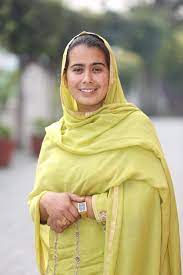 An angry Punjab voted, and voted for “badlaav.” Whatever seemed like a “badlaav” got its vote. From the richest candidate on Punjab’s firmament, Kulwant Singh of Mohali, to the utterly simple, poor, young, determined daughter of Punjab Narinder Kaur Bharaaj in Sangrur.
An angry Punjab voted, and voted for “badlaav.” Whatever seemed like a “badlaav” got its vote. From the richest candidate on Punjab’s firmament, Kulwant Singh of Mohali, to the utterly simple, poor, young, determined daughter of Punjab Narinder Kaur Bharaaj in Sangrur.
Meanwhile, the key issues that Punjab faces continue to stare it in the face. Peasantry continues to be in a crisis, unemployment remains rampant, law and order remains an issue, the state of Dalit and landless labourer remains pitiable, and an ecological crisis is threatening civilisational decimation.
Better governance promised by AAP could possibly provide some relief in education and health sectors, but how will AAP live up to its promise of punishing those who looted Punjab for decades when many of its MLAs have actually come from the same traditional parties? Punjab has voted in AAP because the other political parties were shorn of any intra-party democracy and had become fiefdoms. But then, where is the democracy within AAP? It is a highly centralised party where the day Punjab gave it 92 seats, the party was represented on television screens by Kejriwal and Manish Sisodhia in Delhi and Raghav Chadha in Punjab.
अब भारत को दुनिया का नंबर 1 देश बनने से कोई नहीं रोक सकता
– श्री @ArvindKejriwal #AAPSweepsPunjab pic.twitter.com/dqKwbNBN5J
— AAP (@AamAadmiParty) March 10, 2022
Kejriwal appeared in Delhi and on TV screens on the evening of March 10, greeting Punjabis across the world with Vande Mataram and Bharat Mata Ki Jai, and ended with Vande Mataram, Inquilab Zindabad and Bharat Mata Ki Jai. Not one leader at the AAP office shouted Bole So Nihal, and not one spoke of Punjab, Punjabi, Punjabiyat. Kejriwal talked about building the entire country now.
“Saare Aam Aadmi Party join kar lo ab,” he exhorted those listening to him, asking businessmen, traders, students, youth, women, everyone to join the “revolution.”
Kejriwal appeared in Delhi and on TV screens on the evening of March 10, greeting Punjabis across the world with Vande Mataram and Bharat Mata Ki Jai, and ended with Vande Mataram, Inquilab Zindabad and Bharat Mata Ki Jai. Not one leader at the AAP office shouted Bole So Nihal, and not one spoke of Punjab, Punjabi, Punjabiyat.
The Kejriwal model of politics will have no element of Punjabiyat, a concept outside the remit of this piece, but his model for Punjab seems to be cast in the Modi mould: link party and government. Ensure service delivery to citizens, keep free power units supply line running, ensure teachers in schools and do not let go of the narrative of nationalism. He will soon be at the Golden Temple in Amritsar for the mandatory photo-op with the Darbar Sahib in the backdrop, just as he will be at Durgiyana Mandir and, probably, at some temple raised to the god who had once burnt down a country for his lord.
But anyone trying to run down the 92/117 verdict by Punjab people has no right to call himself/herself democratic. The verdict means something. And possibly, it means many things at the same time. But at its core, it means a yearning for change. Badlaav. People have brought about that. It would have taken progressive, educated, English-speaking, Kafka-quoting, Huntington-spewing democratic liberal left-of-centre or centrists years or decades to achieve in one day what Punjab’s people delivered in the initial couple of hours of counting: a complete decimation of the old order and its leading faces. Some of the older faces have sneaked in, and there’s also a Rana Gurjit to snub anyone trying to utter “badlaav” in that Swiss-French Charles-Édouard Jeanneret-designed building called the Punjab Assembly, but then there are many correctives that still remain to be applied. Finding the Punjab AAP in Kejriwal’s AAP is also a major task on hand, and both, the “Delhi Model” and “Punjab Model”, will either find new alignments or new interfaces of conflict to resolve.
Has Punjab elected a BJP-Lite government? Only time will tell, or the next wave of agitational politics.
To those Punjabis who found closure in 92/117 verdict and the defeat of Badals Sr and Jr, Bikramjit Majithia, Navjot Sidhu, Charanjit Channi, Amarinder Singh and umpteen others, and went to bed with a sense of peace and achievement, hope you read the newspapers.
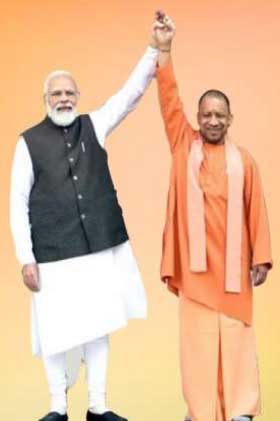 In this hyper-connected flat world called Modi’s India, neither your state nor your politics exists in a vacuum. You cannot pontificate about Punjab’s streak of ‘naabri’ and at the same time refuse to engage with the result in Uttar Pradesh. Yogi’s victory, too, is a revolution of the other side, but Kejriwal will have little interest in getting Punjab to engage with it. The politics of ‘guarantees’ has very strong limitations.
In this hyper-connected flat world called Modi’s India, neither your state nor your politics exists in a vacuum. You cannot pontificate about Punjab’s streak of ‘naabri’ and at the same time refuse to engage with the result in Uttar Pradesh. Yogi’s victory, too, is a revolution of the other side, but Kejriwal will have little interest in getting Punjab to engage with it. The politics of ‘guarantees’ has very strong limitations.
The Inquilab Zindabad slogan and our icons like Shaheed Bhagat Singh are now all very elastic — anyone can stretch these to fit any agenda. So, Bhagwant Mann will be sworn in at Khatkar Kalan and you can bet that Kejriwal will raise his fist and shout “Inquilab Zindabad,” which, in the short run, will mean he plans to now find star pracharaks in Bhagwant Mann and his ilk for his next venture in Himachal Pradesh or Gujarat and will eventually take Bhagat Singh’s iconography to a bigger stage by 2029 for a Kejriwal versus Yogi Adityanath clash for the top job in the country.
Am I running far too fast into the future?
Let me quote from Arvind Kejriwal’s speech immediately after the Punjab election results: “Nothing was done earlier. We have wasted 75 years. Let us start building now. Bharat Mata Ki Jai, Vande Matram!”
It could as well have been Narendra Modi’s first speech in 2014.
Has Punjab elected a BJP-Lite government? Only time will tell, or the next wave of agitational politics. Even after the stupendous victory Punjabis have granted to AAP, Punjab continues to be rife with ominous signs. To some, including me, these are the only signs of hope.
![]() SP Singh is a Chandigarh-based senior journalist who has covered Punjab politics for more than two decades, writes for leading publications, anchors the weekly cerebral Punjabi television talkshow ‘Daleel with SP Singh’ and dabbles in subjects ranging from academia, media, arts and, yes, even trivia. He can be contacted at singh.india@gmail.com and is too shy to be on social media. An abridged iteration of this piece was published in Deccan Herald within hours of the result on March 10, 2022. This expanded version is exclusive to the WSN.
SP Singh is a Chandigarh-based senior journalist who has covered Punjab politics for more than two decades, writes for leading publications, anchors the weekly cerebral Punjabi television talkshow ‘Daleel with SP Singh’ and dabbles in subjects ranging from academia, media, arts and, yes, even trivia. He can be contacted at singh.india@gmail.com and is too shy to be on social media. An abridged iteration of this piece was published in Deccan Herald within hours of the result on March 10, 2022. This expanded version is exclusive to the WSN.


